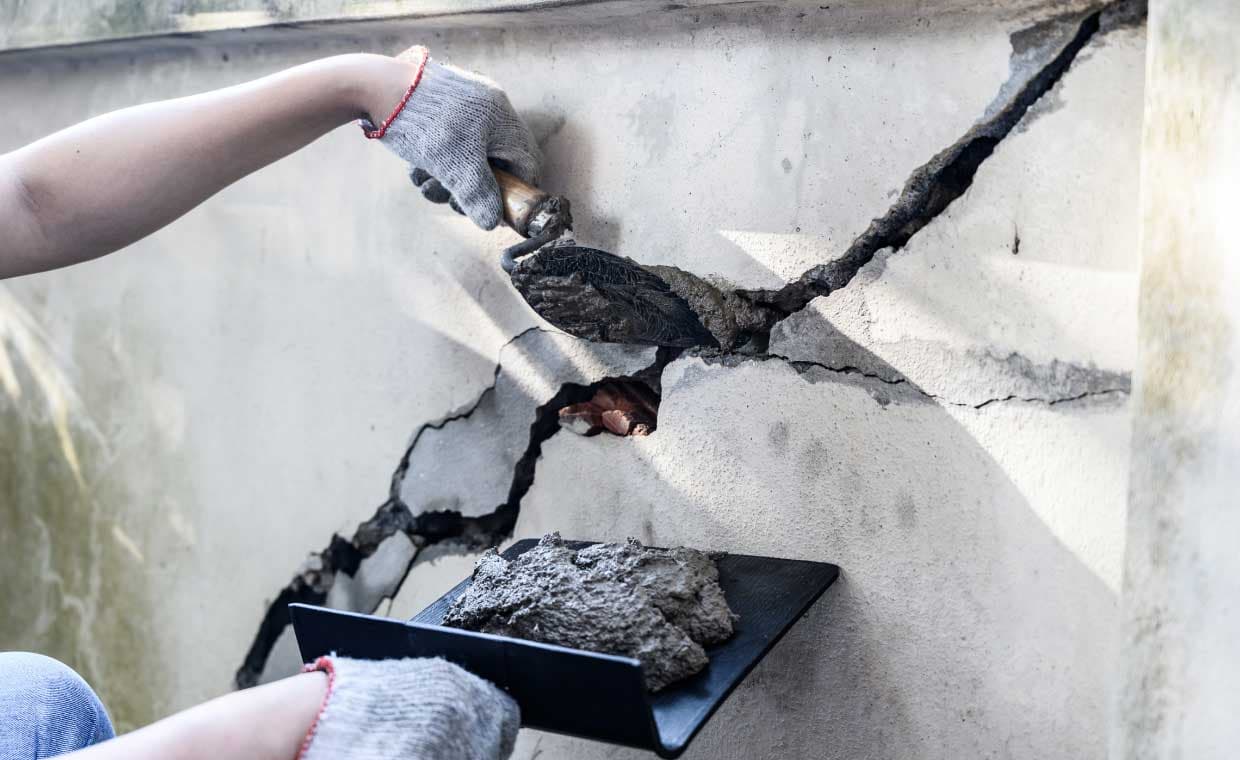
Table of Contents
Concrete repair work is essential for maintaining the structural integrity of homes and buildings. Over time, concrete structures can develop cracks, spalls, or other types of damage due to exposure to weather, wear and tear, and shifting foundations. Choosing the right repair materials and chemicals can extend the lifespan of structures, improve safety, prevent recurring damage, and maintain property value. This comprehensive guide provides information on the best concrete repair materials and chemicals.
Learn more about the causes of cracks here: 8 Basic Causes of Cracks in House
List of Concrete Repair Materials and Chemicals
- Non-Shrink Grouts
- Repair Mortars
- Ferrocement – Fiber Concrete
- Fiber Reinforced Plastics or Polymers (FRP)
- Bonding Agents
- Admixtures
- Sealants
- Epoxy Resins
1. Non-Shrink Grouts

Courtesy - indiamart
Grouts are used to repair cracks and fill voids in masonry structures. Grout is a mixture of water, cement, sand, and other additives designed to enhance performance. Unlike regular cement grouts, non-shrink grouts contain non-shrink cement, high-quality sands, and polymers. These grouts do not shrink and maintain their volume during the setting process, providing high strength as an additional benefit.
Today ready-mix non-shrink grouts of consistent quality are widely available. Some popular examples of non-shrink grouts are Fosroc Conbextra GP, SikaGrout – 214, BASF MasterFlow 928, MAPEI Plaingrout 712, MYK LATICRETE Grout 220, etc.
2. Repair Mortars

Courtesy - indiamart
Mortar is a mixture of cement, sand, and water, used for binding bricks, stones, or concrete blocks. Repair mortar is an advanced type of mortar enhanced with admixtures such as polymers or fibers. These additives improve its adhesion, strength, and durability, making it an essential material for repairing cracks in concrete. It is widely used in external wall repairs, concrete patching, and reinforcement protection to maintain structural integrity and prevent further deterioration. Repair mortars such as rapid hardening mortar, rapid drying mortar, slump-free mortar, patching and repairing mortar, and fine finished mortar are easily available in the market. Some examples of repair mortars are Fosroc Renderoc Range, Sika Repair Mortars, BASF MasterEmaco Range, Dr. Fixit Repair Mortars, Ultratech Ready-to-use Mortars, MYK LATICRETE Repair Mortars, etc.
3. Ferrocement – Fibre Concrete

Ferrocement and fibre concrete are innovative materials for concrete repair, known for their exceptional mechanical properties, durability, and versatility. Ferrocement is a reinforced concrete where wire mesh is reinforced in cement mortar. It has high tensile strength, durability, and the ability to withstand cracking. This material is commonly used in repairing thin concrete structures, such as walls, roofs, and water tanks, where flexibility and strength are essential.
Fibre concrete integrates fibres, such as glass, steel, polypropylene, or natural fibres into the cement mix. These fibres provide tensile and flexural strength to the concrete, making it more resistant to cracking, impact, and shrinkage. Fibre concrete is used to repair pavements, industrial floors, and structural components that experience high loads.
The combination of ferrocement and fibre concrete is a cost-effective and long-lasting solution in modern repair techniques and construction projects.
4. Fiber Reinforced Plastics or Polymers (FRP)

Courtesy - indiamart
Fibre Reinforced Plastics (FRP) or Fiber Reinforced Polymers, are advanced composite materials widely used for concrete repair, strengthening, and retrofitting applications. FRP is a cutting-edge solution for modern concrete repairs. FRP is a polymer resin matrix reinforced with high-strength fibres like glass (GFRP), carbon (CFRP), or aramid fibres. This concrete repair material offers an exceptional strength-to-weight ratio, durability, and corrosion resistance.
FRP effectively repairs and strengthens damaged structural elements such as beams, columns, slabs, and walls, exposed to harsh environmental conditions or chemical attacks. FRP wraps, sheets, and laminates are commonly used to increase the load-bearing capacity and extend the life of concrete structures.
5. Bonding Agents
Bonding agents are natural, compounded, or synthetic materials designed to improve the adhesion between old and new concrete surfaces. These agents ensure a strong and durable bond, preventing separation or delamination over time. Bonding agents are used for patching cracks, overlaying concrete, or joining precast concrete elements. Following are the types of bonding agents used in construction:
Latex Emulsion Bonding Agents

Courtesy - indiamart
They are further classified as Styrene Butadiene (SBR) latex, Polyvinyl Acetate (PVA) latex (Non-Re-Emulsifiable and Re-Emulsifiable), Acrylic Latex, and Epoxy Latex (Produced from liquid epoxy resin mixed with the curing agent or wetting agent or emulsifying agent). These are flexible and commonly used for non-structural repairs. They bond fresh concrete with old concrete. Some popular latex emulsion bonding agents are Sika Latex Power, Dr. Fixit Pidicrete URP, BASF MasterEmaco P 2520.
Epoxy Resin Bonding Agent

Courtesy - indiamart
They are used to bond fresh concrete to cured concrete and concrete to steel. This will create a monolithic bond capable of transmitting high stresses and is therefore used to bond structural elements such as beams, columns, and slabs. They contain resins that are 100 percent solid. Resin possesses excellent water and alkali resistance. Ideal for bonding fresh concrete to cured concrete or concrete to steel. Some popular epoxy resin bonding agents include: Forsroc Nitobond EP, SikaDur 32, Ardex Abacrete.
6. Admixtures

Courtesy - indiamart
Admixtures are added to the mix (concrete or mortar) to modify and enhance its properties while preparing the mix. Admixtures improve the workability, strength, durability, and performance of the mix. Hence, they are commonly used for repairing cracks and waterproofing. They are further classified based on their concrete repair applications:
Plasticizers and superplasticizers – BASF MasterGlenium Range, Sika ViscoCrete Series, Fosroc Conplast SP.
Waterproofing admixtures – Dr. Fixit LW+, CICO No.1 Waterproofing Compound, SikaCim Waterproofing Compound.
Shrinkage-reducing admixtures – BASF MasterLife SRA 20, Fosroc Conplast SHR, Mapei Expansive Agent.
Accelerators and retarders – Sika Set Accelerator, Fosroc Cebex 100 (Retarder), BASF MasterSet AC Series.
Fibre admixtures – Fosroc Polypropylene Fibers, Sika Fiber Reinforced Admixtures, BASF MasterFiber Series.
Also Read: Importance of Concrete Admixtures & their Types
7. Sealants

Courtesy - indiamart
Sealants are used to fill joints, cracks, and gaps. They prevent the infiltration of water, air, dust, and other contaminants. They are widely used in construction joints, expansion joints, and crack repairs for both structural and non-structural members. Sealants are classified based on their composition, such as:
Polyurethane sealants – SikaFlex® Construction+, Fosroc Thioflex 600, BASF MasterSeal NP 1
Silicone Sealants – Dow Corning 789, Pidilite M-Seal Silicone Sealant, SikaSil® C
Acrylic Sealants – Fosroc Flamex One, Sika® Acrylic , Dap Acrylic Latex Caulk
Epoxy Sealants – Araldite Epoxy Adhesive, Mapei Eporip, BASF MasterInject 1380
Hybrid and Specialty Sealants – 3M Polyurethane Hybrid Sealant 505, Hilti HIT-RE 500 V3, Dr. Fixit Flexi PU Sealant
8. Epoxy Resins

Courtesy - indiamart
Epoxy resins offer excellent bonding strength. Epoxy resin is a thermosetting polymer created by combining epoxy resin with a hardening agent. It is the most effective material for concrete repair and structural strengthening. It has high tensile strength and resistance to wear. Applications of epoxy resins are crack injection, adhesive bonding, protective coatings, and grouting. Following are some commonly used epoxy resins for concrete repair and construction.
Epoxy Crack Injection Resins – SikaDur – 52, Fosroc Nitofill EP Range, Dr. Fixit Expoxy Injection Grout.
Epoxy Bonding Agents – SikaDur 32, Fosroc Nitobond EP, BASF MasterBrace ADH 2200.
Epoxy Coatings and Grouts – BASF MasterProtect 170CR, Araldite Epoxy Resin, Mapei Epoject.
Also Read:
Concrete Cracking: Know its Types & Appearance at Various Age
Construction Chemicals: An Essential Component for Speedy Construction!






























